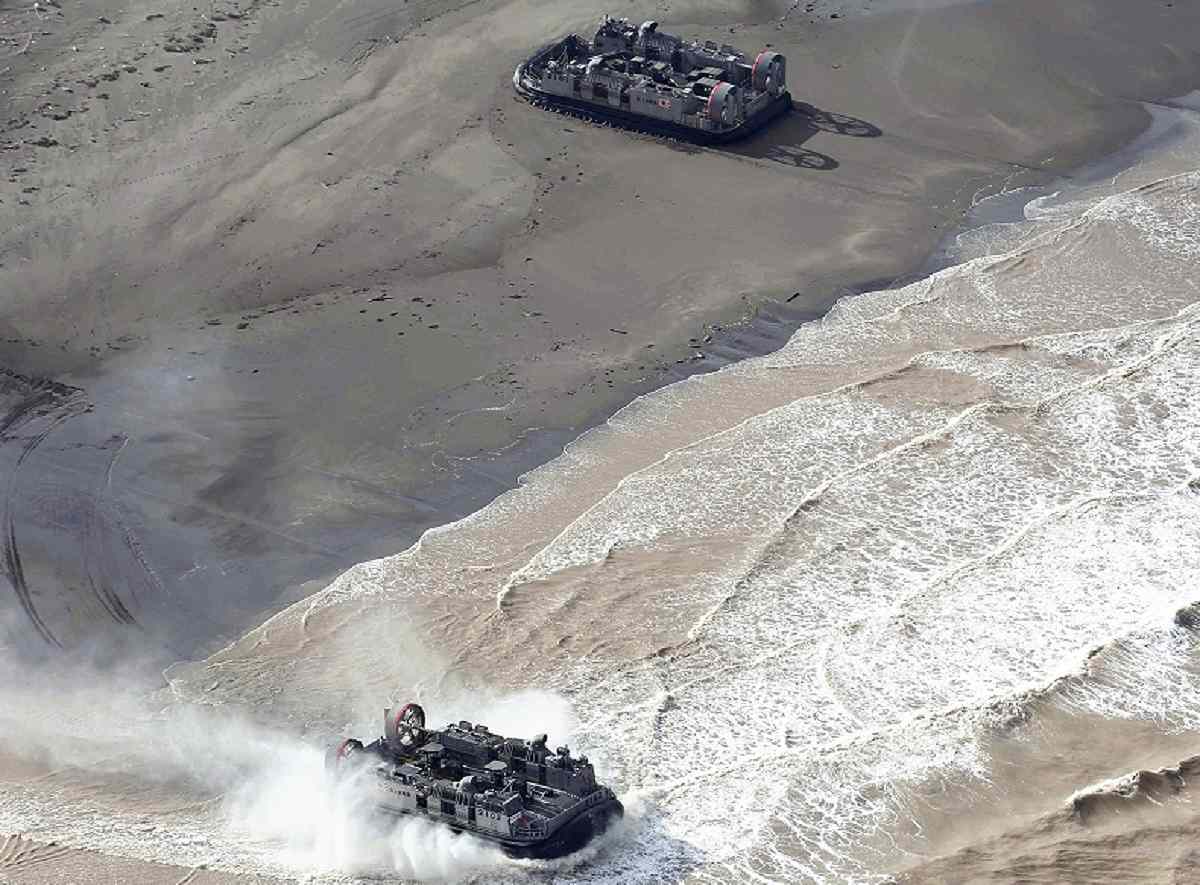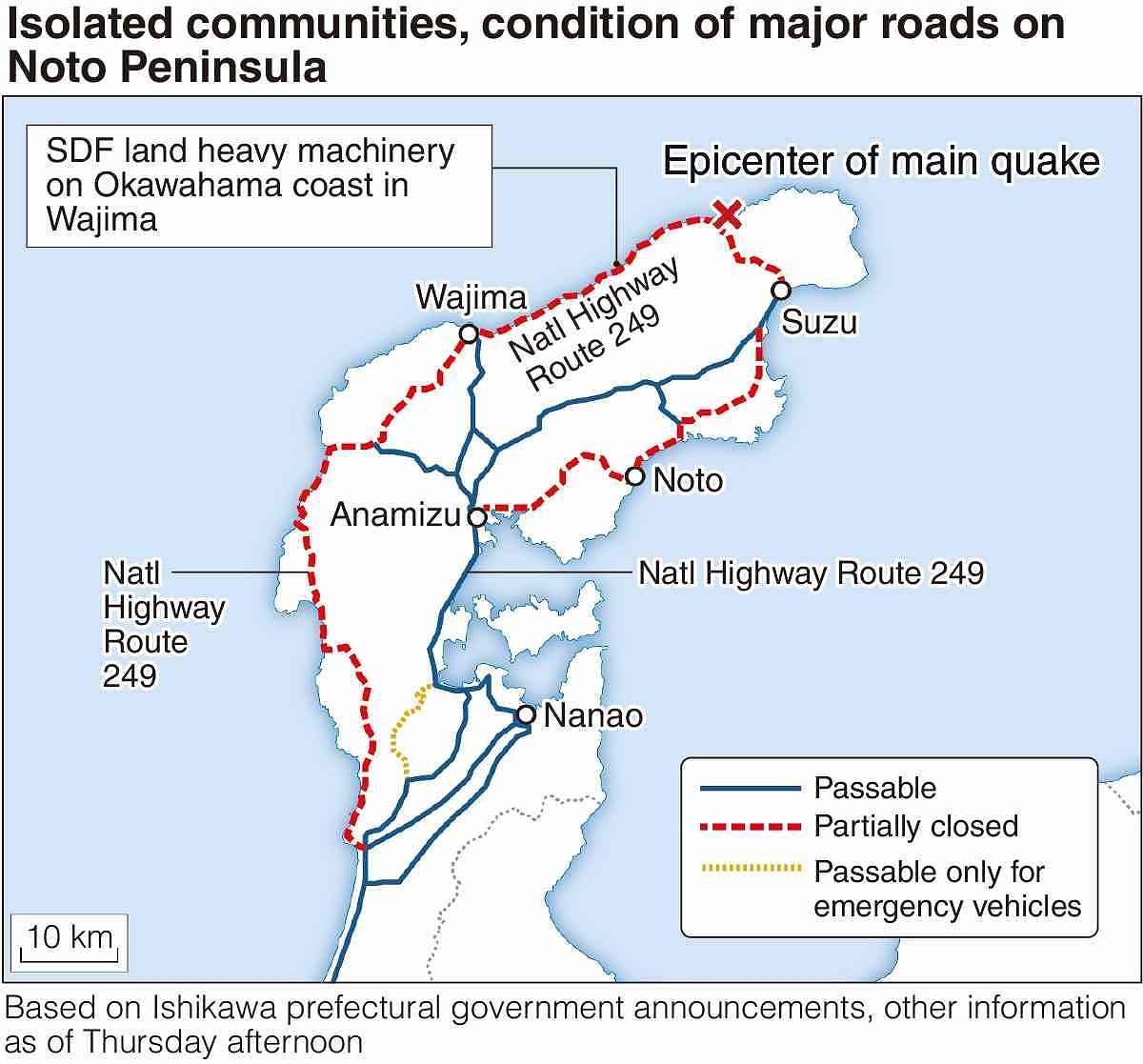Access to Some Quake-Hit Areas Still Difficult in Japan; SDF Landing Craft Used to Get Heavy Equipment Ashore

A pair of LCACs (landing craft air cushion) of the Maritime Self-Defense Force are seen near the coast of Wajima, Ishikawa Prefecture, at 10:02 a.m. Thursday.
17:22 JST, January 5, 2024
KANAZAWA — The survival rate of people trapped after an earthquake is said to drop significantly after the first 72 hours. In the aftermath of the Jan. 1 Noto Peninsula Earthquake, that point was reached on Thursday afternoon.
The earthquake, which registered a maximum seismic intensity of 7 on the Japanese scale, was larger than the Ishikawa prefectural government had anticipated, and it brought devastation to a wide area. The search for missing persons has not been easy. Major roads have been severed and the communications environment has been disrupted, making it difficult to respond to the disaster.
Race against time
About 15 members of a rescue team dispatched from Kyoto Prefecture were engaged in rescue operations at a collapsed house where an elderly woman lived alone Thursday afternoon in the Kasugano coastal district of Horyumachi in Suzu, Ishikawa Prefecture.
Since other collapsed houses blocked roads around the house, it was difficult to bring heavy machinery there. Amid aftershocks, the rescue workers continued their efforts with electrical saws, shovels and other tools, shouting: “Rescue is here! Is there anybody in there?” They found an unconscious woman at around 5:30 p.m. and pulled her out of the house.
A fire department official from Kyoto Prefecture who led the rescue operation said they had arrived at the district about a day after the earthquake. “Given the 72-hour window for saving lives, a late arrival would make things worse,” the official said.
‘Cannot contact’
Roads and communication networks in areas affected by the earthquake remain in bad condition.
According to the Land, Infrastructure, Transport and Tourism Ministry, the Ishikawa prefectural government and others, landslides, cave-ins and other damage occurred in at least 25 locations on National Highway Route 249, the main arterial road on the Noto Peninsula. As of Thursday, only one road was passable to the center of Suzu, along with one other road to the center of Wajima.
Five municipalities on the peninsula were seriously affected by the earthquake, with more than 700 residents isolated in a total of 30 districts.
It was Thursday afternoon, about 70 hours after the earthquake, when emergency repairs of roads leading to Wajima and Suzu were completed and large vehicles were able to use the roads.
“Both mobile and landline networks have been disrupted and roads were severed. We cannot contact some communities at all,” Wajima Mayor Shigeru Sakaguchi said at a meeting of the prefectural government’s disaster response headquarters Thursday morning at the prefectural government building.
“We still do not fully understand how many people are missing or unaccounted for,” he said.
Landing heavy machinery
The Ishikawa prefectural government released names and other information about people whose whereabouts were unknown at about 11 p.m. Wednesday for the first time. The prefecture has its own rule under which it should release such information about 48 hours after the occurrence of a disaster. However, the information was actually released about 55 hours after the earthquake. Nine people were found to be safe after the release, meaning that rescuers might have made some unnecessary searches.
Ishikawa Gov. Hiroshi Hase said Thursday, “I sincerely apologize for the delay, [which occurred] because municipal officials in Wajima and Suzu are also affected by the earthquake and communication services have been disrupted.”
The Self-Defense Forces used the Maritime Self-Defense Force’s transport ship Osumi, along with LCAC (landing craft air cushion) vessels to land heavy machinery such as hydraulic shovels and bulldozers on the Okawahama coast of Wajima on Thursday. The machinery was to be used to remove debris blocking roads and rescue people under collapsed houses, among other operations.
Along with rescue operations, the SDF will have its members visit disaster-hit locations and evacuation shelters to listen to people affected by the disaster, aiming to offer the victims better support.

"Society" POPULAR ARTICLE
-

M4.9 Earthquake Hits Tokyo, Neighboring Prefectures
-

Israeli Tourists Refused Accommodation at Hotel in Japan’s Nagano Pref., Prompting Protest by Israeli Embassy and Probe by Prefecture
-

M7.5 Earthquake Hits Northern Japan; Tsunami Waves Observed in Hokkaido, Aomori and Iwate Prefectures
-

Tsukiji Market Urges Tourists to Avoid Visiting in Year-End
-

M5.7 Earthquake Hits Japan’s Kumamoto Pref., Measuring Upper 5 Intensity, No Tsunami Expected
JN ACCESS RANKING
-

Tokyo Economic Security Forum to Hold Inaugural Meeting Amid Tense Global Environment
-

Keidanren Chairman Yoshinobu Tsutsui Visits Kashiwazaki-Kariwa Nuclear Power Plant; Inspects New Emergency Safety System
-

Imports of Rare Earths from China Facing Delays, May Be Caused by Deterioration of Japan-China Relations
-

University of Tokyo Professor Discusses Japanese Economic Security in Interview Ahead of Forum
-

Japan Pulls out of Vietnam Nuclear Project, Complicating Hanoi’s Power Plans






















